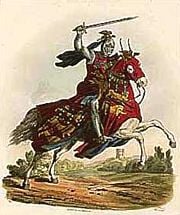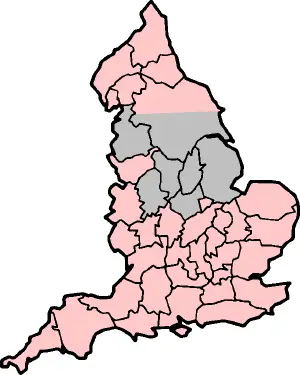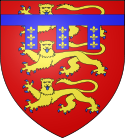Thomas Plantagenet, 2nd Earl of Lancaster
Thomas, Earl of Lancaster (c. 1278 – March 22 1322) was one of the leaders of the baronial opposition to Edward II of England.
Lineage
Thomas was the eldest son of Edmund Crouchback, 1st Earl of Lancaster and Blanche of Artois. His paternal grandparents were Henry III of England and Eleanor of Provence. His maternal grandparents were Robert I of Artois and Matilda of Brabant, who was a daughter of Henry II, Duke of Brabant.
Titles and lands
From his father Thomas inherited the Earldoms of Lancaster, Leicester, and Derby.
By his marriage to Alice de Lacy, Countess of Lincoln, daughter of Henry de Lacy, 3rd Earl of Lincoln, he became Earl of Lincoln, Earl of Salisbury and the 11th Baron of Halton upon the death of his father-in-law in 1311. Master of five earldoms, he was one of the wealthiest and most powerful men in England.
Thomas was in possession of many key fortesses, particularly in northern England. He was responsible for the extension of Pontefract Castle and in 1313 he began the construction of Dunstanburgh Castle a massive fortress in Northumberland.
Marriage
His marriage to Alice de Lacy was not successful. They had no children, though he had two illegitimate sons. In 1317 she was abducted from her manor at Canford, Dorset by Richard de St Martin, a knight in the service of John de Warenne, 8th Earl of Surrey. This incident caused a feud between Lancaster and Surrey; Lancaster divorced his wife and seized two of Surrey's castles in retaliation. King Edward then intervened, and the two Earls came to an uneasy truce.
Although divorced from his wife, he continued to hold the powerful Earldoms of Lincoln and Salisbury. This was due to the marriage contract the two families had agreed, in effect upon the death of his father-in-law, Earl Thomas held these earldoms in his own right, not in right of his wife.
Conflict with Edward II and death
He served in the coronation of his cousin, King Edward II of England, on February 25, 1308, carrying Curtana, the sword of St Edward the Confessor. At the beginning of the King's reign, Lancaster openly supported Edward, but as the conflict between the king and the nobles wore on, Lancaster's allegiances changed. He despised the royal favourite, Piers Gaveston, who mocked him as "the Fiddler", and swore revenge when Gaveston demanded that the King dismiss one of Lancaster's retainers.
Lancaster was one of the Lords Ordainers who demanded the banishment of Gaveston and the establishment of a Baronial oligarchy. His private army helped separate the King and Gaveston, and Lancaster was one of the "judges" who convicted Gaveston and saw him executed.
After the disaster at Bannockburn in 1314, Edward submitted to Lancaster, who in effect became ruler of England. He attempted to govern for the next four years, but was unable to keep order or prevent the Scots from raiding and retaking territory in the North. In 1318 a new faction of barons arose, and Lancaster was deposed from office.
The new leadership, eventually headed by Hugh le Despenser, 1st Earl of Winchester and his son Hugh the younger Despenser, proved no more popular with the Baronage, and in 1321 Lancaster was again at the head of a rebellion. This time, however, he was defeated at the Battle of Boroughbridge, and taken prisoner.
Lancaster was tried by a tribunal consisting of, among others, the two Despensers, Edmund FitzAlan, 9th Earl of Arundel, and King Edward. Lancaster was not allowed to speak in his own defence, nor was he allowed to have anyone to speak for him. Because of their kinship and Lancaster's royal blood, the King commuted the sentence to mere beheading (as opposed to being drawn, quartered, and beheaded) and Lancaster was convicted of treason and executed near Pontefract Castle.
In 1326 or 1327 Parliament posthumously reversed Thomas's conviction, and Henry Plantagenet was further permitted to take possession of the Earldoms of Lancaster, Derby, Salisbury and Lincoln.
Thomas became venerated as a martyr and saint within a few months of his death. Hagiographies were written about him, and Edward III wrote three times to the Pope requesting his canonisation. He was never canonised, though rumours to that effect arose in the 1390s, when his cult experienced something of a revival.
Upon his death his titles and estates were forfeited, but in 1323 his younger brother Henry successfully petitioned to take possession of the Earldom of Leicester.
Titles, styles, honours and arms
Arms
Inherited from his father, Thomas bore the arms of the kingdom, differenced by a label France of three points (that is to say azure three fleur-de-lys or, each).[1]
ReferencesISBN links support NWE through referral fees
- Given-Wilson, C. (June 1994). Richard II, Edward II, and the Lancastrian Inheritance. The English Historical Review 109 (432): 553–571.
- Maddicott, J. R. (1970). Thomas of Lancaster, 1307–1322: A study in the reign of Edward II. Oxford: Oxford University Press. ISBN 0198218370.
- Mortimer, Ian (2003). The Greatest Traitor. ISBN 0224062492.
| Honorary Titles | ||
|---|---|---|
| Preceded by: The Earl of Leicester and Lancaster |
Lord High Steward 1296–1322 |
Succeeded by: The Earl of Leicester and Lancaster |
| Peerage of England
| ||
| Preceded by: Edmund Crouchback |
Earl of Leicester and Lancaster |
Succeeded by: Henry of Lancaster |
br:Thomas Lancaster de:Thomas Plantagenet, 2. Earl of Lancaster el:Τόμας, 2ος κόμης του Λάνκαστερ fr:Thomas de Lancastre (2e comte de Leicester) no:Thomas Plantagenet, 2. jarl av Lancaster
Credits
New World Encyclopedia writers and editors rewrote and completed the Wikipedia article in accordance with New World Encyclopedia standards. This article abides by terms of the Creative Commons CC-by-sa 3.0 License (CC-by-sa), which may be used and disseminated with proper attribution. Credit is due under the terms of this license that can reference both the New World Encyclopedia contributors and the selfless volunteer contributors of the Wikimedia Foundation. To cite this article click here for a list of acceptable citing formats.The history of earlier contributions by wikipedians is accessible to researchers here:
The history of this article since it was imported to New World Encyclopedia:
Note: Some restrictions may apply to use of individual images which are separately licensed.


